|
Splendid People received 5 stars in BIAFF 2008.
Splendid People is based around an interview with Sonia Rolt,
widow of writer L.T.C. Rolt. Sonia was one of the young women recruited by
the government during World War II, to work as trainee boatwomen running
pairs of 70ft narrowboats carrying essential materials on the canal system.At the end of the war, when all the others left, Sonia remained and spent
a further five years as a working boatwoman, later marrying Tom Rolt who
co-founded the Inland Waterways Association.
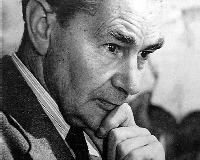 Robert Langdon
Robert Langdon |
It was during Sonia's time on the canals that she met and became friends
with an amateur photographer, Robert Longden, who used to record the scene
around Hawkesbury Junction near Coventry. Many years later Sonia was able
to gain access to some slides that had survived when his negatives and
photographs had been thrown out after his death. It was these slides that
she was able to have restored in order to provide the images for a book she
had published in 1997. |
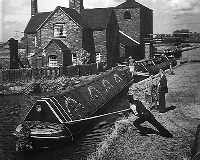 Hawkesbury Junction
Hawkesbury Junction |
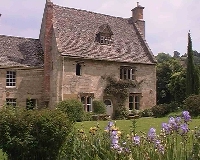 Sonia'a house
Sonia'a house |
My wife Von and I have known Sonia for a good number of years and we've
become friends. Each year we rent a cottage, idyllically set in an old cider
orchard, behind her 14th century house in the Cotswolds. When her book of
canal photographs came out we bought a copy and took it for her to sign.
I decided to film the signing without any idea how or when it might be used. |
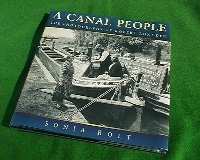 Sonia's book
Sonia's book |
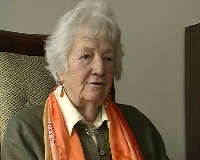 Interviewing Sonia
Interviewing Sonia |
It was in 2002 that I thought that I ought to record Sonia's memories
of her time on the canals, again without any idea how I might use the material.
We set up the interview in her front room, with Sonia talking to Von who
sat to my right - I believe that interviewees should never talk directly
to the camera unless absolutely unavoidable. Presenters - yes, interviewees
- no. |
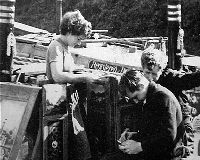 Sonia in the 1940s
Sonia in the 1940s |
| Sound was recorded via a tie-clip mic. It's a bit 'toppy', a factor which
elicited one or two adverse comments from the BIAFF judges. As a result I've
since tweaked the base and treble response in Adobe Premiere. Sonia is a
perfect interviewee and an excellent speaker - she often gives talks to various
groups about her life on the canals. She is totally unfazed by the camera
and was, in fact, interviewed for the BBC Countryfile programme on board
a narrowboat at the 2007 National Waterways Festival. My interview with Sonia
lasted 25 minutes with just four brief pauses. The tape was then consigned
to the cupboard along with the others.
It was 2005 before I listened to the interview tape again and I'd also been
having another look at the book of photographs. It occurred to me that by
using some of Sonia's words, illustrated by the pictures in the book, there
was, perhaps, the making of a film. Should be a 'piece of cake' - I thought!
The first step was to film some of Sonia's own wartime photographs in her
album whilst staying at the cottage. Back home I then set about selecting
and filming the pictures in the book - most of them in fact. My usual method
is to stand a book upright with the pages held flat with bulldog clips and
kept from closing by means of an old burglar alarm battery. For illumination
I use an Anglepoise lamp. With the book upright on the bench I can easily
perform zooms, pans and tilts to give some movement. To avoid showing any
white borders, I connect the camera to the computer via a firewire and check
the image in the Premier Movie Capture window. |
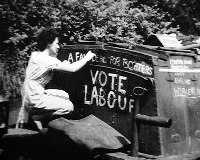 Sonia at the end of the war
Sonia at the end of the war
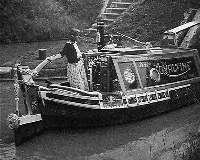
|
| As well as Sonia's own photographs, and those of Robert Longden, I needed
a picture of a group of trainee boatwomen. A trawl through the canal books
at our local library brought up one which just fitted the bill. However,
I would need to clear the copyright - the Longden images were no problem,
Sonia holds the copyright on those. The acknowledgements at the back of the
library book told me that the photograph was part of a particular collection.
Research on the internet suggested that the collection was held at The Boat
Museum, Ellesmere Port in Cheshire. I rang the museum and explained about
the film I was making and the photograph I was after. The lady there didn't
think they had that collection but she would check and ring me back.
A week later she called to say no they definitely didn't have it but there
was just a possibility it might be at the National Waterways Museum in
Gloucester. It so happened that the following weekend we were planning a
visit to Ellesmere Port as we'd never been before and I needed a shot of
a traditionally sheeted up narrowboat. Whilst there we met a lady volunteer
who was herself doing some research. I told her about my film and, after
describing the photograph she said she was confident that it would be at
Gloucester. The archivist there was a Caroline Jones who was usually prompt
at answering emails and she gave me her address.
As we were going down to the Cotswolds again in a couple of week's time I
quickly contacted Caroline, describing the photograph. She replied saying
she was certain they had it and suggested we made an appointment to visit.
The Archive is tucked away in an attic at the top of the Waterways Museum
which is housed in an old warehouse at Gloucester docks. Caroline had the
album of photographs ready and, sure enough, there was the one I wanted.
Then, on looking through the other photographs, I found another three that
would fit my commentary perfectly. As my film was for non-commercial use
she agreed to waive any copyright fee but I would have to pay the standard
charge of £6 plus VAT each for scanning the negatives. A worthwhile
investment I thought. She also asked for a copy of the film for the museum.
To complete my Cotswold filming I just needed a few introductory location
shots. First, a close-up of the sign-post bearing the name of the hamlet
where Sonia lives - Stanley Pontlarge. 'Pontlarge' is of Norman French origin
and sufficiently unusual to grab an audience's attention. A wide shot with
a passing car came next, to give an audience a little time before the commentary
would start, followed by shots of the lane leading up to the hamlet. |
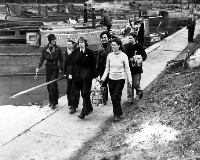 The elusive photograph
The elusive photograph
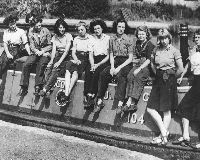 Trainee boatwomen - Sonia on left
Trainee boatwomen - Sonia on left
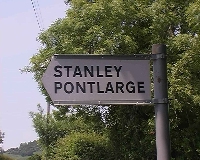 Opening shot
Opening shot |
| Robert Longen's photographs were mostly taken at Hawkesbury Junction
where the Oxford and Coventry canals meet, and shots of the junction as it
is today would make an effective ending to the film. As it isn't far off
our regular route from the M1 motorway it would mean only a slight detour.
I had hoped to do the filming on the way down but it was Spring Bank Holiday
2006 and, needless to say, the weather was absolutely appalling with heavy
rain. However, for our return journey, there was a mini heat wave with wall
to wall sunshine - ideal for good pictures. The junction today is an attractive
place, and a haunt of pleasure craft. The canal-side pub was very much
appreciated on such a hot day! |
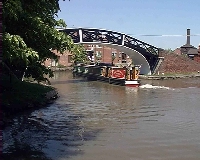 Hawkesbury junction today
Hawkesbury junction today |
| With everything 'in the can' the first job was to copy the Sonia interview
onto VHS tape with the timecode burnt in. This was then used to select and
log the sections that would tell the story and be illustrated by the photographs.
Similarly the tape of the photographs was copied along with its timecode,
as were the modern-day Hawkesbury shots. The book-signing sequence, together
with the house exteriors, had been shot on my Hi8 Sony V800 which was now
no longer operational, so the material was transferred onto Mini DV using
a borrowed Digital 8 recorder before copying to VHS.
My usual practice is to write a draft commentary then make an off-line linear
edit using the timecoded VHS, modifying the commentary as I go along. The
timecodes of each shot are then logged for capturing in the computer. Selecting
the clips in timecode order avoids running the camera backwards and forwards
when capturing. In the case of Splendid People I only linear
edited the live action sequences. For the rest, I inserted photographs on
the Premiere timeline to fit Sonia's comments and wrote commentary to fit
further photographs as I went along. Sonia is quite photogenic but it is
always a good principle to limit the amount of 'talking head'.
The commentary mentions the government's scheme for trainee boatwomen whilst
Sonia is signing the book, so that was the point I had to cut to the photograph
I had found in the library book. However, I then had to cut back to the
book-signing and later dissolve to the interview - not very satisfactory.
Finding the additional photographs in the Waterways Museum archive solved
the problem perfectly, fitting the commentary and also Sonia's opening line. |
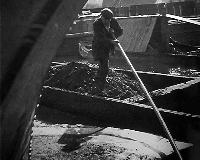
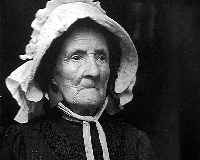 |
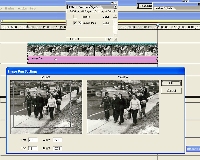 Applying the image pan effect
Applying the image pan effect |
With the film assembled it was time to set about adding some life to
the photographs. I had done some camera movements when copying but most were
static and I had no wish to end up with a slide show. However, I found that
using the motion effects in Premiere resulted in a slight, but perceptible
loss of image quality. A fellow club-member came to the rescue by suggesting
the use of the 'Image Pan' effect, one I had never looked at before. It proved
to be the perfect answer with no degradation of the image and easy to use,
providing the ability to simulate panning and zooming with the camera. I
also found that applying the motion, or even the image pan effect, could
sometimes result in patterning of the image. That problem was solved by exporting
a frame and re-importing it as a bitmap image back into Premiere. |
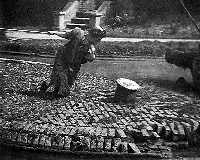 |
| The next stage was to reduce all the photographs to the same level of
black and white. This was done by means of the saturation effect, taking
it down to zero. It was also applied to a coloured live-action sequence
comprising shots taken from my film Waterway to Wales. I used
it behind Sonia's description of the pleasures of travelling along. There
is a Black and White effect in Premiere but its use creates a significant
drop in image quality and is best avoided.
For the finishing touch I needed a title. The working title was Canal
People, taken from the title of Sonia's book, but that would have
been too obvious - titles should be enigmatic. I always think that an
unimaginative title is likely to be the precursor to an unimaginative film.
Listening to Sonia's words again I realised she'd given me the perfect title
when she described them as 'really very splendid people'. So that was it.
| 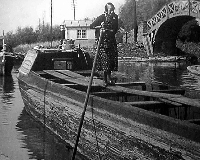
|
| For a title background I selected a photograph of a group of three jolly-looking
boatmen sat on top of a narrowboat and clutching a jar of cider. Using Photoshop
I gave it a sepia look, faded round the edges in the manner of an old photograph.
The BIAFF judges queried my use of a picture of only men when the emphasis
in the film tends to be on the women. I must confess, it hadn't occurred
to me. I'd used that photograph as they were such a happy looking bunch.
|
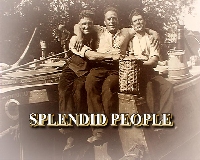 Opening title
Opening title |
| The commentary was to be read by my regular narrator, fellow club member
Geoff Parkin. Former amateur thespian Geoff speaks well and has the ability
to pick up a script, scan through it once, then read it straight through,
usually without a muff. Most retakes are due my changing the intonation of
a particular word. My normal method is to record from a professional Sennheiser
microphone onto VHS tape. I can then just select the best passages for capturing
into the computer.
Finally, I needed some music. I'd particularly arranged the narration to
leave interludes for music and pictures only. The music is from film library
discs collected over the years, including some from the sponsor's prize that
I received when Waterway to Wales won Best Use of Sound at
BIAFF 2004. As copies of the film would be going to the Waterways Museums
at Gloucester and Ellesmere Port I thought it best to use copyright-free
music on those, so a version 2 was created.
It's my policy to leave a film in the computer until after it's been in two
or three competitions. Splendid People has had adjustments
in accordance with judges' comments in three competitions - including the
replacing of a commentary line. I was pleasantly surprised when it received
five stars and even more surprised when I found that there were only five
winners at that standard. Anyhow, Sonia is very pleased with it and now shows
it whenever she gives her frequent talks about her life as a boatwoman. |
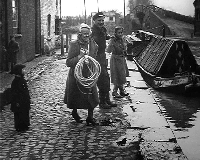
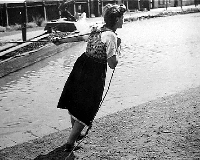
|
This is the third canal film I've worked on. I wrote and edited our club
production Restoration: Impossible, which was awarded the Denham
Gold Cup for the best club entry at BIAFF2002. That was about the construction,
decline and restoration of the Huddersfield Narrow Canal. Then in 2004
Waterway to Wales, which is about a narrowboat journey along
the Llangollen canal. However canals are not a special interest - history
is my particular interest - I enjoy doing the necessary research. A prime
example is Bailey's Bath, a film about a long defunct open
air swimming bath in the Summer Wine town of Holmfirth. Produced for Huddersfield
Video and Ciné Club by myself and Trevor Spencer it won the Denham
Gold Cup and the Best Documentary Award in 2000.
When I embarked on Splendid People I thought it would be a
simple matter to fit a few photographs to a voice-over and some comments
from the Sonia interview. How wrong I was - I've decided that live-action
films are much easier!
Dave Whitworth FACI(M) June 2008
 Join us on Facebook
Join us on Facebook
 UNICA member
UNICA member
Company Limited by Guarantee No. 00269085. Registered Charity No. 260467.
Authors' views are not necessarily those of the Institute of Amateur Cinematographers.
Website hosted by Merula. JavaScripts by JavaScript Source. Menu by Live Web Institute.
Art work by Tony Kendle.
|

